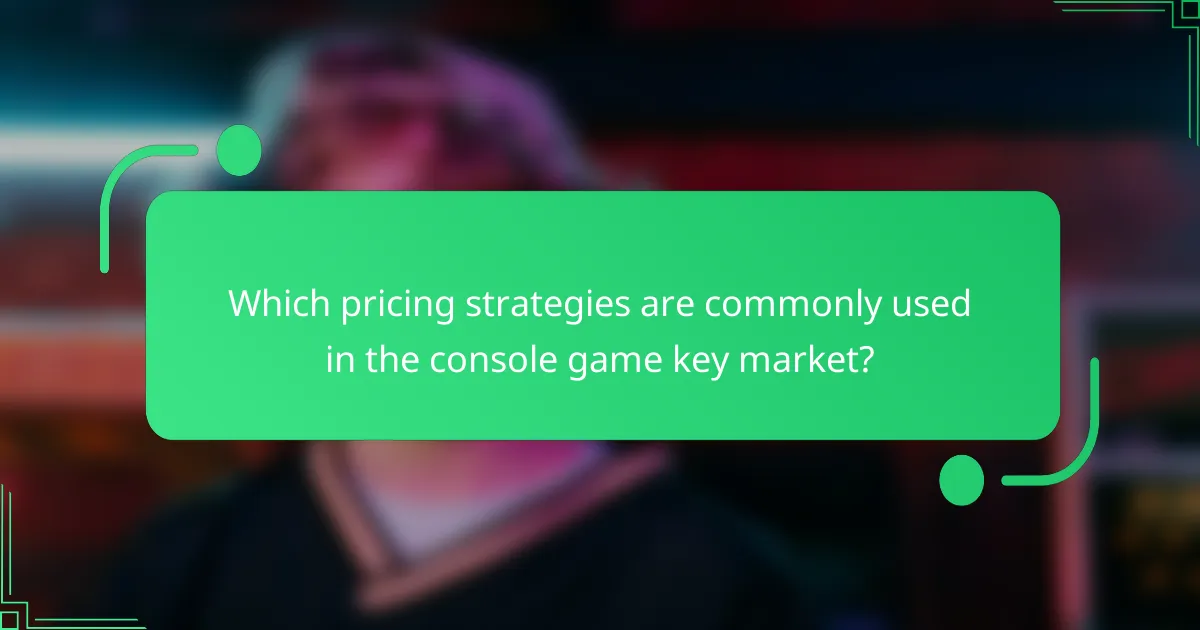Understanding console game key pricing strategies is essential for developers and retailers to maximize sales and customer satisfaction. Key factors include market demand, competition, and consumer behavior. Common strategies like dynamic pricing, discounting, and bundling reflect these market dynamics. Additionally, regional variations and unique attributes of games further influence pricing decisions.

What are the key factors influencing console game key pricing strategies?
Several key factors influence console game key pricing strategies, including market demand, competition, and consumer behavior.
Market demand significantly impacts pricing, as high demand can lead to increased prices. Competition among retailers and digital platforms also affects pricing strategies, often resulting in discounts or promotions. Additionally, consumer behavior, including purchasing trends and willingness to pay, plays a crucial role in determining the final price of game keys.
The unique attributes of specific games, such as exclusivity or brand reputation, can further influence pricing. Seasonal trends and game release schedules may also create rare pricing opportunities, affecting overall market dynamics.
How do market demand and supply dynamics affect pricing?
Market demand and supply dynamics significantly influence console game key pricing. When demand exceeds supply, prices typically rise, reflecting consumer willingness to pay. Conversely, when supply outstrips demand, prices may decrease as sellers compete for buyers. Seasonal trends and promotional events can also impact these dynamics, leading to temporary price fluctuations. Understanding these factors helps consumers make informed purchasing decisions and enables sellers to optimize pricing strategies.
What role do consumer preferences play in pricing decisions?
Consumer preferences significantly influence pricing decisions in the console game key market. Understanding these preferences helps companies optimize their pricing strategies to attract consumers.
Factors such as brand loyalty, perceived value, and market trends shape how consumers respond to pricing. For example, a strong preference for a specific gaming franchise can lead to higher willingness to pay, allowing companies to set premium prices.
Additionally, limited-time offers or discounts can cater to price-sensitive consumers, creating urgency and boosting sales. The interplay of these consumer behaviors and preferences directly impacts pricing strategies, ensuring alignment with market dynamics.
By analyzing consumer feedback and purchasing patterns, businesses can adjust their prices effectively, enhancing competitiveness and maximizing revenue.
How do regional economic conditions shape pricing models?
Regional economic conditions significantly influence console game key pricing strategies by affecting supply, demand, and consumer purchasing power. Economic factors such as inflation rates, currency fluctuations, and regional income levels shape how prices are set. For instance, high inflation may lead to increased prices, while a strong local currency can lower costs for consumers. Additionally, consumer behavior varies with economic stability; in robust economies, gamers may spend more on premium titles, impacting pricing models. Understanding these dynamics helps companies tailor their strategies to maximize sales across different markets.

Which pricing strategies are commonly used in the console game key market?
Common pricing strategies in the console game key market include dynamic pricing, discounting, and bundling. Dynamic pricing adjusts based on demand and competition, ensuring competitive positioning. Discounting offers reduced prices during sales or promotional events, attracting budget-conscious consumers. Bundling combines multiple game keys at a lower total price, enhancing perceived value. These strategies reflect market dynamics and consumer behavior, aiming to maximize sales and customer satisfaction.
What are the benefits of competitive pricing in this market?
Competitive pricing in the console game key market enhances market share, attracts price-sensitive consumers, and fosters brand loyalty. It encourages competition, leading to better deals for customers. Additionally, it can stimulate demand during slow sales periods. By offering lower prices, businesses can differentiate themselves, appealing to a broader audience.
How does value-based pricing impact consumer perception?
Value-based pricing enhances consumer perception by aligning prices with perceived value. This strategy fosters trust and loyalty, as consumers feel they receive fair value for their investment. Additionally, it differentiates products in a crowded market, allowing brands to position themselves effectively. As a result, consumers are more likely to engage with brands that demonstrate a clear understanding of their needs and preferences.
What is the significance of discounting and promotional pricing?
Discounting and promotional pricing are crucial for attracting consumers and boosting sales in the console game key market. These strategies create urgency and enhance perceived value, encouraging purchases. Discounts can also help clear inventory and respond to competitive pressures. Understanding consumer behavior reveals that price sensitivity varies, making tailored promotions effective.

How do digital distribution platforms affect console game key pricing?
Digital distribution platforms significantly influence console game key pricing by increasing competition and price transparency. These platforms enable developers to reach a wider audience, often resulting in lower prices due to market saturation.
Consumer behavior shifts as players compare prices across multiple platforms, driving down prices. Additionally, sales and discounts on these platforms create a dynamic pricing environment, affecting perceived value.
The unique attribute of digital distribution is its ability to offer instant access, which can justify higher prices during initial releases. However, rare promotional events often lead to significant price drops, impacting overall pricing strategies.
As a result, understanding these market dynamics is crucial for developers and retailers to optimize their pricing strategies effectively.
What are the implications of platform exclusivity on pricing strategies?
Platform exclusivity significantly influences pricing strategies by creating scarcity and perceived value. Exclusive titles often command higher prices due to limited availability, driving demand among consumers. This strategy can lead to increased revenue for console manufacturers and developers, as loyal customers are willing to pay a premium for exclusive content. Additionally, platform exclusivity can shape competitive dynamics, as companies may adjust their pricing to attract or retain users. As a result, understanding these implications is crucial for stakeholders in the gaming industry.
How do platform fees influence final pricing for consumers?
Platform fees can significantly raise the final pricing for consumers. These fees, often charged by digital distribution platforms, are typically a percentage of the sale price. For instance, if a console game key costs $50 and the platform fee is 30%, the developer receives only $35. This impacts pricing strategies, as developers may increase retail prices to maintain profit margins. Consequently, consumers face higher costs, which can influence their purchasing decisions. Understanding these dynamics is crucial for consumers navigating the console game market.

What are the unique attributes of console game key pricing in different regions?
Console game key pricing varies significantly across regions due to factors like market demand, local purchasing power, and currency fluctuations. Unique attributes include regional pricing strategies that adapt to consumer behavior and competitive landscapes. For instance, regions with lower average incomes may see discounted prices or promotional bundles to increase accessibility. Additionally, digital distribution platforms may implement geo-blocking, affecting availability and pricing based on location.
How do cultural factors influence consumer willingness to pay?
Cultural factors significantly influence consumer willingness to pay for console game keys. These factors shape perceptions of value, brand loyalty, and pricing sensitivity.
Cultural norms dictate acceptable price ranges for entertainment, impacting how much consumers are willing to spend. For instance, in cultures where gaming is a mainstream pastime, consumers may exhibit a higher willingness to pay premium prices for popular titles.
Additionally, social status and peer influence can affect purchasing decisions. In some cultures, owning the latest games can be a status symbol, leading to increased demand and higher prices.
Moreover, regional economic conditions and cultural attitudes toward spending can create disparities in pricing strategies. Companies must consider these variables to optimize their pricing models and align them with consumer expectations.
What are the notable differences in pricing strategies between North America and Europe?
North America typically employs competitive pricing strategies for console game keys, while Europe often utilizes value-based pricing. North American retailers focus on market competition to set prices, leading to frequent discounts and promotions. In contrast, European strategies prioritize perceived value, often resulting in higher initial prices but fewer discounts. Currency fluctuations and regional taxes further complicate pricing differences, impacting consumer behavior across both markets.

What rare pricing tactics are employed by leading publishers?
Leading publishers employ rare pricing tactics to maximize revenue while maintaining consumer interest. These strategies include dynamic pricing based on player engagement, limited-time offers, and exclusive bundles. For example, some publishers adjust prices in real-time according to market demand and competition. Additionally, they may leverage psychological pricing, setting prices just below a whole number to enhance perceived value. These tactics reflect a unique understanding of market dynamics and consumer behavior in the console game key sector.
How does dynamic pricing work in the context of console game keys?
Dynamic pricing for console game keys adjusts based on demand, competition, and consumer behavior. This strategy allows retailers to optimize profits by setting prices that reflect real-time market conditions. For instance, during peak gaming seasons, prices may rise due to increased demand, while discounts can occur during off-peak times to stimulate sales. The unique attribute of this pricing model is its responsiveness to market fluctuations, enabling retailers to attract price-sensitive consumers while maximizing revenue.
What are the implications of bundling strategies on pricing?
Bundling strategies significantly impact console game key pricing by influencing perceived value and consumer purchasing behavior. These strategies can create attractive offers, leading to increased sales volume. For example, bundling multiple games at a reduced price enhances the overall value proposition, encouraging consumers to buy more. Additionally, it can differentiate products in a competitive market, allowing brands to target specific consumer segments effectively. As a result, understanding these dynamics is crucial for optimizing pricing strategies and maximizing revenue in the gaming industry.

How can understanding consumer behavior optimize pricing strategies?
Understanding consumer behavior allows for dynamic pricing strategies that align with market demand. By analyzing purchasing patterns, preferences, and price sensitivity, companies can set optimal price points. This enhances sales while maximizing profit margins. For instance, limited-time discounts can create urgency, appealing to consumer psychology. Additionally, understanding unique attributes of target demographics can tailor offers effectively, ensuring alignment with consumer expectations. As a result, businesses can remain competitive and responsive to market fluctuations.
What are the best practices for analyzing consumer buying patterns?
To analyze consumer buying patterns effectively, focus on data-driven insights and market trends. Utilize sales data, customer feedback, and competitor analysis to identify preferences and purchasing behaviors.
Segment your audience based on demographics, psychographics, and buying history to tailor pricing strategies. Monitor price elasticity to understand how changes affect demand, and adjust accordingly.
Incorporate A/B testing to evaluate different pricing models and promotions. This allows for real-time adjustments based on consumer response, enhancing overall strategy effectiveness.
Lastly, leverage advanced analytics tools to gain deeper insights into trends and forecast future buying patterns, ensuring your pricing strategies remain competitive and aligned with consumer expectations.
How can feedback loops from consumers enhance pricing strategies?
Feedback loops from consumers can significantly enhance pricing strategies by providing real-time insights into market demand and consumer preferences. This data allows businesses to adjust prices dynamically, optimizing revenue and improving customer satisfaction. For instance, monitoring consumer reactions to price changes can reveal optimal pricing points and identify price elasticity. Engaging with consumers through surveys or social media can uncover unique attributes of their purchasing behavior, leading to more tailored pricing strategies. Ultimately, leveraging consumer feedback fosters a more responsive pricing model that aligns with market dynamics.
What common mistakes should be avoided when setting prices?
To avoid common mistakes in console game key pricing, focus on market research, competitor analysis, and consumer psychology.
Firstly, neglecting to analyze market trends can lead to mispricing. Understanding demand elasticity helps set competitive prices. Secondly, failing to consider competitor pricing can result in being outpriced or undervalued. Regularly review competitor strategies to align your pricing effectively.
Additionally, overlooking consumer behavior can hinder sales. Utilize data analytics to grasp purchasing patterns and preferences. Lastly, avoid rigid pricing models; flexibility can capture changing market dynamics and consumer expectations.
What expert tips can help in developing effective pricing strategies?
To develop effective pricing strategies for console game keys, focus on market dynamics and consumer behavior. Analyze competitors’ pricing, understand consumer demand, and consider seasonal trends. Implement dynamic pricing to adjust based on market fluctuations. Utilize psychological pricing techniques to influence purchasing decisions. Track sales data to refine strategies continuously.



